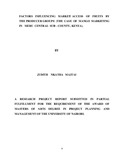| dc.description.abstract | Changes in agriculture are taking place in terms of the fundamental business proposition and the
ways of doing business, example, a shift from spot markets to collective and contracts marketing
models. This is due to the need for a all year-round supply and global change in consumer
preferences e.g. quality, safety, health and nutritional aspects of food products. Interest in quality
management systems, food safety and competition in markets is rising, associated with profitable
agricultural products trade (Agribusiness). This is the reason why in 2004, the Kenya government
developed and launched the Strategy for Revitalizing Agriculture (SRA), Which sets out the
Government’s vision: To transform Kenya’s agriculture into a profitable, commercially oriented,
internationally and regionally competitive economic activity that provides high quality and
gainful employment to Kenyans.
This research study on factors influencing market access of fruits, specifically on mango by the
producer groups was conducted in Meru Central sub-county. The objectives of the research was to
get how producer groups networking, negotiation, logistics costs and post-harvest handling
measures affected their mango market access. Background to the study, problem statement,
purpose, limitations and delimitations to the study were indicated. Literatures review based on
the four objectives was discussed. 12 mango groups were purposively selected, 120 farmers
respondents randomly selected and 5 stakeholders purposively selected in the study. Documentary
analysis and questioner data collection instruments were used. Data was analyzed using Statistical
Package of Social Scientists (SPSS) and presented both qualitatively and quantitative using
descriptive method and SPSS tables respectively. Relationships between dependent and
independent variables was done using cross tabulations. There were four major finding and
conclusions from the research. Networking with market linkaging stakeholders was minimal
compared to technical advises and information.A large percentage of the farmers had mutual
agreement, while farmers had no organized plan to meet the transportation costs which was rated
highest in market logistics. Access to high value market was possible to farmers who owned a
cooler, while the rest sold mango at local or farm- gate markets. Further research to establish
whether technical expertise on mangoes had led to improved mango quality and quantities was
recommended. | en |

